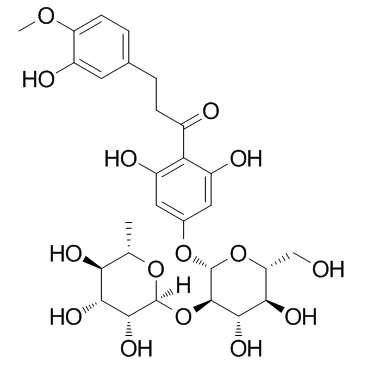Subchronic (13-week) oral toxicity of neohesperidin dihydrochalcone in rats.
B A Lina, H C Dreef-van der Meulen, D C Leegwater
Index: Food Chem. Toxicol. 28(7) , 507-13, (1990)
Full Text: HTML
Abstract
Neohesperidin dihydrochalcone was administered to groups of 20 male and 20 female Wistar rats at dietary levels of 0, 0.2, 1.0 and 5.0% for 91 days. No treatment-related ophthalmoscopical, haematological or histopathological effects were observed. In the high-dose group, a marked caecal enlargement occurred in both sexes, accompanied by soft stools in the early stages of the study, somewhat lower plasma urea concentrations and increased plasma alkaline phosphatase activity and a decreased urinary pH. This group also showed slight growth depression accompanied by transient reduction in food intake; in males the body weights remained relatively low throughout the experimental period. Furthermore, bilirubin level was increased in females and total protein level was decreased in males of the high-dose group. The above changes were considered adaptive responses or chance effects rather than manifestations of clear toxicity. The low-and intermediate- dose groups did not show any compound-related untoward effect. It was concluded that the intermediate dose, providing an overall intake of about 750 mg neohesperidin dihydrochalcone per kg body weight per day, was the no-effect level.
Related Compounds
| Structure | Name/CAS No. | Molecular Formula | Articles |
|---|---|---|---|
 |
Neosperidin dihydrochalcone
CAS:20702-77-6 |
C28H36O15 |
|
Protective effects of neohesperidin dihydrochalcone against ...
2014-04-01 [Chem. Biol. Interact. 213 , 51-9, (2014)] |
|
Determination of high-intensity sweeteners in river water an...
2015-05-08 [J. Chromatogr. A. 1393 , 106-14, (2015)] |
|
Neohesperidin dihydrochalcone: presentation of a small molec...
2013-03-18 [FEBS Lett. 587(6) , 652-8, (2013)] |
|
Determination of nine high-intensity sweeteners in various f...
2011-06-01 [Anal. Bioanal. Chem 400 , 2159-72, (2011)] |
|
Metabolic engineering of plant cells for biotransformation o...
2005-12-14 [J. Agric. Food Chem. 53(25) , 9708-12, (2005)] |